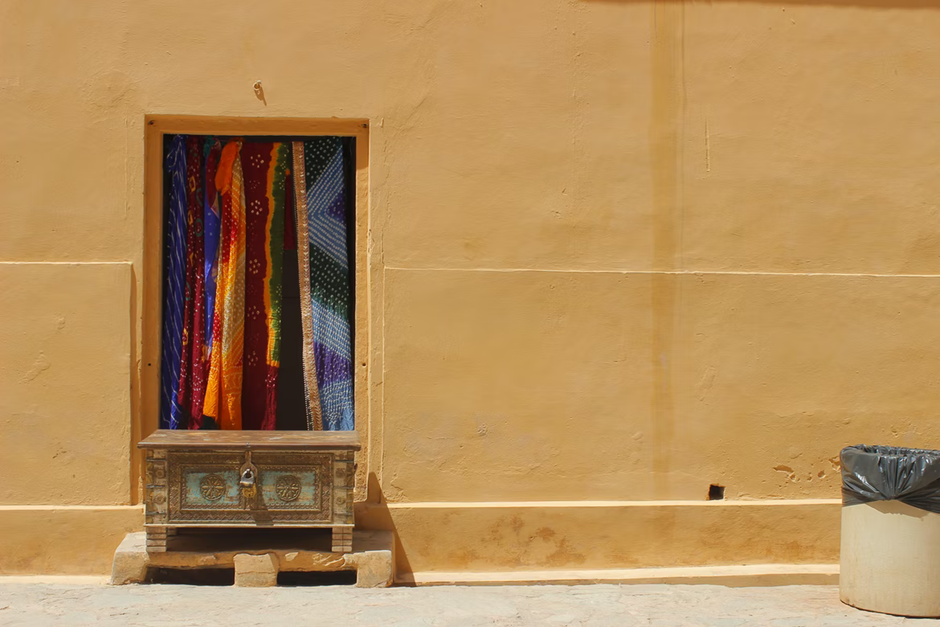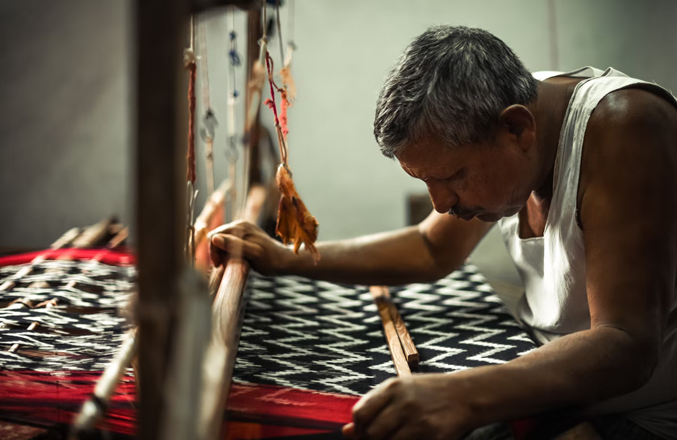KHADI AND IT’S SAGA –A CONTINUED STORY OF ELEGANT AND ETHICAL FASHION!
What is Khadi?

Technically Khadi refers to any natural fabric that is hand spun, be it cotton, silk, jute or wool. Unlike the mill made cloth, Khadi is a craft so precious that it is deeply ingrained into the culture of India. The role it has played out in the freedom struggle of the country is unique and unparalleled.
THE HISTORY OF KHADI
India started weaving early. Cotton cultivation and weaving practices existed ever since the bronze age period in India. The processing of cotton and the production of cloth -with embroideries existed in the Indus valley civilization. Hand spinning and hand weaving were quite prevalent in prehistoric India and this is evident from the oldest Vedas and Manu smriti. Exotic textiles crossed the borders of the Indian subcontinent through the “maritime Silk Road” via Arabian -Surat merchants to Rome and via the Silk route that stretched all the way up to the Mediterranean. India has always had a rich and exotic history in textiles.
Khadi in the freedom struggle
In the beginning of the 17th century, the English East India company set foot in India. The company progressively expanded its network. By the 18th century a lion's share of the total value of the company’s sales consisted of Indian textiles. Indian workers meanwhile were subjected to inhumane conditions. The Indian farmer, trader, artisan, craftsmen all felt the brunt of the oppression of the Raj. Touched by the plight of the farmers during the Champaran satyagraha and the Kheda mill strike Gandhi stressed the importance of indigenous khadi and hand spinning. He envisaged this rustic coarse fabric as a symbol of resistance against the British. It emphasized self-sufficiency and thus paved a way out of the poverty and doom the population faced. Giving the masses a fresh sense of hope, he himself donned the khadi, and spearheaded the Khadder or khadi movement whereby grass root level khadi institutions were set up to encourage spinning and weaving. Gandhiji designed India’s fashion those days. He even invented the Patti charkha whereby the act of spinning was simplified and exhorted Indians to weave in their spare time. Thus, Khadi rose to prominence and became a national symbol for self-reliance and an icon of the Swadeshi movement. In 1921 Charkha (spinning wheel) became the symbol of the Indian flag. The newly imbibed swadeshi spirit flared up with the boycott movement whereby, foreign goods were dumped and the dying industry was lent a fresh start. As the fabric of Indian independence, khadi is a symbol of self-reliance and self-sufficiency promoting sustainability and ethical fashion.
Khadi in the post-independence era

Post-Independence, Prime minister Pandit Jawaharlal set out the plans for the development of the country envisioned through the 5-year plans. The 2nd five-year plan gave importance to Industries and the country’s industrial policy was set in 1948.The role of the Rural cottage industries was recognised through this resolution and the All-India Khadi and Village Industries Board was set up in January 1953. The government continues to promote the use of Khadi through various initiatives. The revenues from Khadi in the last financial year stood at ₹3,215 crore. A target of ₹5000 crore was set to be achieved by 2020.
Prime minister Shri Narendra Modi asserts that Khadi cloth is in fact a movement to uplift the weaker sections of the society and he stressed the importance of the role of Khadi and Village Industries Commission (KVIC) -a statutory organisation, promoting and developing khadi and village industries. The Khadi and the village industries commission has with its continued efforts tried to promote the cloth by various means. The Modi government has focused on Khadi, on its marketing and tie-ups with corporates because it can create employment with very minimum investment.
To ensure the genuineness of khadi,” KHADI MARK” has been notified by the Government of India. Through its assisted institutions and units KVIC participates in various international exhibitions. It has entered into tie ups with NIFT-National Institute of Fashion technology to bring in innovative quality product designs. KVIC had participated in the International Exhibition in St. Petersburg, Russia organized by ITPO (Indian Trade Promotion Organization) from 12th to 14th March ,2019 with 10 Khadi village industry institutions /units from Rajasthan, Himachal Pradesh, West Bengal, Karnataka, Gujarat and Kerala. The exhibition provided an opportunity and an apt platform to showcase the quality of khadi village industry products. KVIC has with its efforts made khadi products more competitive and appealing in the domestic as well as overseas market.
KHADI IN THE PRESENT SCENARIO
Khadi is essentially a rustic, traditional fabric. Whatever it may symbolize, it is not practically possible to get everyone, particularly the younger generation to embrace it all at once.
We prefer everything organic, pure and preservative free these days. With grass fed poultry, organic vegetables, cruelty free makeup, the onus has shifted to sustainable fabric. Stress is given to ethical consumerism and sustainability in fashion. Khadi leaves less carbon footprint on our earth as manufacturing of one metre of Khadi requires just 3 litres of water as against 56 litres of water for mill fabric. Designers and fashion labels have already identified the potential of khadi in projecting it as a global fabric as it promotes ethical and sustainable fashion, leaving lesser impacts upon Mother Earth.
This coarse rustic fabric that had once borne the stamp of being uncomfortable and resistant to designs has become the face of ethical, sustainable and indigenous fashion these days. This rustic, coarse yet breathable fabric has revamped itself under the watchful and innovative guidance of brilliant designers. Khadi in its newest avatar gains fame and recognition at international levels.
When we think of khadi and of course Gandhiji, the movie- “GANDHI” comes to our mind. Bhanu Athaiyya designed clothes in khadi for the actor Richard Attenborough who essayed the role of Gandhiji in the movie and won the first academy award for India in the best costume section.
Sabyasachi Mukherjee – the one name khadi remains forever indebted to. With his innovative designs he took Khadi to international recognition.
Rohit Bal who is associated with Khadi Gram Udyog is a top Khadi fashion designer in India.
For more and extensive styles in khadi you can always follow the designs of Debarun Mukherjee, Wendell Rodricks, Swati Mehrotra, Anju Modi, Reynu Tandon, Gaurang Shah, Ritu Beri.
Some of the labels that have served well for the purpose of Khadi are Khanijo,11:11, Akaaro, THREE, P’ero, Yavi, Maku Textiles, Beej, Bodice, The Pot Plant, Red Sister Blue, Bunosilo, Runaway Bicycle, Runaway Bicycle, Metaphor Racha.
The label- “LOVE THE WORLD TODAY” deserves special mention as they design clothes for kids with herbal dyes, organic cotton and sustainable fibres with khadi featuring prominently in their designs.
WHAT CAN WE DO?
Khadi has truly metamorphosed itself. The year 2022 will mark the 153rd Birthday anniversary of Gandhiji. In fact, 2022 has just begun-Onam, Vishu, Diwali -all the festivities of the year await us. Let us all take a note to buy ourselves a set of khadi costumes or gift someone dear a khadi set of dresses. This may be a wonderful way to keep up the spirit and ingenuity of the fabric-something it has held true to this date. Khadi embodies the emotion of our nation. Let us wear it with pride and gift our loved ones a set of khadi costumes. It will be a wonderful way to promote this unique fabric and lend a hand in the development of this sector and the nation at large.
